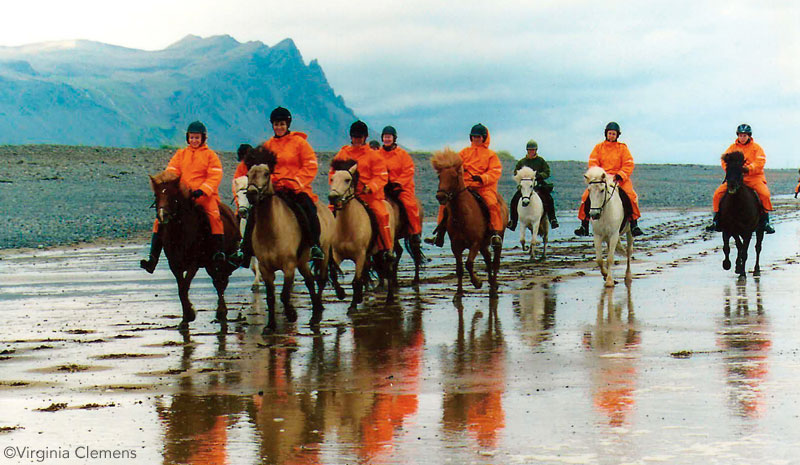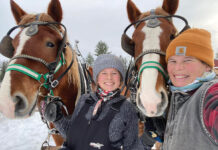
It was raining, as it did at some point almost every day, but we were fully protected by the high rubber boots and bright orange rain suits that had been doled out to us the first day. Our group of 16 vacationers and three guides was trying to save several hours of travel time with a shortcut, but it was going to be close.
We rode Icelandic horses—sturdy, strong, pony-sized mounts with long, thick manes and tails. Descendants of horses brought to Iceland by the Vikings in their longboats, the Icelandics have their own gait, the tölt, a fast running walk that is easy and a lot of fun to ride, as well as the usual walk, trot, and canter. Some horses also have a fifth gait, the speedy flying pace.
Accelerating into a gallop, I periodically looked up in the direction we were going, squinting to keep the water out of my eyes. I wasn’t sure if the water was falling from the sky or splashing up from the ever-deepening seawater under the horses’ hooves.
Suddenly, the horses in front of me dropped down and, except for their heads, disappeared. Before I could hesitate, my horse and the other riders’ horses alongside me plunged into a wide, water-filled channel that the incoming tide had filled. Immediately the horses began swimming as the cold water went down into our boots. The light rain and splashing sea sprayed our faces, but everyone was laughing and joking as the horses leaped onto the far bank and tölted or cantered on.
When Oddur finally held up his hand to signal us to slow down to a walk, we knew we had beaten the tide. Now all we wanted was a hot supper and dry feet.
Fun Facts about Icelandic Horses
Learn more about the Icelandic horse by visiting the United States Icelandic Horse Congress at www.icelandics.org. — Kim Abbott Klimek |
Welcome to Iceland
I visited Iceland in the month of July, flying on Icelandic Air into the capital of Reykjavík. I stayed at Hotel Eldhestar on a horse farm outside the horticultural community of Hveragerdi, a town in the southern part of the island where the geothermal energy has been harnessed for the greenhouse cultivation of many kinds of vegetables, fruits and flowers.
I met the rest of the riders—two Icelandics, four Swedes, one Dane, seven Germans and one Swiss—on our tour of the Snaefellsnes Peninsula, considered to be the most unique and picturesque area of Iceland. A flight from the mainland of western Europe takes just two to four hours, so many Europeans vacation here.
Oddur drove us in a minibus down to a field where we met our mounts, about 55 Icelandic horses in a variety of shades and color combinations. Iceland boasts about 80,000 horses, all born on the island because horses are not allowed to be imported into Iceland today. In fact, if any of the native horses leave the island, they cannot return—a very effective way of eliminating equine diseases.
We watched as Oddur, his daughter, Hanna, and helper Siggi circled the herd on foot. At first, the horses galloped off with heads high and manes and tails flying, but eventually they settled down and milled about in a corner of the field with only a string corral containing them.
Oddur studied his list of horses and then waded quietly into the herd, patting first one and then another, speaking to them in a low, reassuring voice. When he came upon the “chosen one,” he put an arm over its neck and gently slid the bridle on. Leading the horse to the edge of the makeshift corral, he would introduce it to its rider.
“Ginny, this is Mosi. He has a sensitive mouth, is four-gaited, and may trot, so you’ll have to work to get a smooth tölt.”
Mosi, my first mount of 11 different horses in four days, was a mousy gray gelding with a dark stripe down his back and a black mane and tail. I led him over to my pile of equipment and began to saddle him while the others were doing the same with their assigned mounts.
After some instruction about the horses’ gaits and how to ride them, particularly the tölt, we set off first at a walk and then at the faster tölt as we became accustomed to our mounts. Our ride took us along country lanes, through lowland meadows and beside a highway, which, like many of Iceland’s roads, had wide riding paths parallel to it.
Catching Waves
The next day we rode down to a beach where we tölted for miles along the water’s edge, walking only periodically. We stopped to watch some seals sunning on rocks just off shore, and a few of the curious ones swam in closer to stare at us.
Then we were off, tölting, galloping, even racing down the beach. We clattered over round rocks and splashed through small waves as the light glinted off the wet sand. Some of us couldn’t help laughing out loud, a prelude to the next few days.
Dinner that night was delicious—trout, potatoes and salad—but the conversation at the table was all about our riding that afternoon.
“Thrilling, exciting, a lot of fun!”
“I just kept smiling the whole time we were riding.”
“These Icelandics are great—so well-trained!”
Then, since it was still light so late in the evening at that latitude, we pulled heavy shades across the windows so it was easier to sleep.
Fishing for Fun
The next morning, Oddur drove us to a little fishing village near the end of the peninsula. The road ran between the mountains and the ocean, and we marveled at the many beautiful waterfalls made by the melting ice of the Snaefellsjökull glacier.
The village, a summer home for many vacationers from Reykjavík, sat high up on a point of the peninsula overlooking the ocean. The waves had carved out unusual formations—caves, inlets, holes and bridges—in the rocky cliffs below, and arctic terns, seagulls and other sea birds had nests on the ledges.
Driving back, we passed old volcanoes, some still considered active, that were surrounded by craggy lava fields. Often, the sharp, rough edges of the black lava were softened by a layer of spongy green moss.
The ride in the afternoon included the entire herd so that we could change horses a couple of times and move them all to a different area. About 12 riders rode in front of the herd of loose horses, while seven rode behind to keep them all together. We tölted across inlets and dunes; through huge, black rock outcroppings; and out onto wide sand flats at low tide.
Then we made a temporary string corral, unsaddled our horses, and led them into the corral where we unbridled them and waited for Oddur to assign us our next mounts. Before motorized vehicles, this was the way Icelanders traveled—with a small herd of extra horses so they could change mounts, rest those not being ridden, and keep moving.
All of the Icelandic horses I rode were well-trained, good-natured and very sure-footed. It was easier to get a smooth tölt on some, but they could all do it.
Oddur told us that in Iceland, unruly, poor riding horses are culled and only the better mares and stallions are bred in order to maintain the integrity of the Icelandic breed.
Icelandic Travel planner
How much sightseeing do you want to include in your visit? How difficult a ride can you manage? How much riding do you wish to do—every day, a couple of times a week, all day, or an hour or two a day? Check out travel company websites to help you decide what you want to include in your itinerary. Accommodations can range from community centers and mountain huts with sleeping bags to guest houses with hot tubs and hotels with beds and linens. Basic lodgings are the usual offering, but all choices have wonderful home-cooked meals. The outfitters usually provide safety helmets, rain gear and rubber boots year-round, and warm overalls in the winter. Your outfitter will suggest various items to bring, but I have included a list below of things that are recommended.
If you’re going to Iceland, riding clothes should be washed and shoes cleaned with a disinfectant to prevent diseases from being brought into the country and infecting the Icelandic horses. |
Beautiful Sights
Oddur took us to a natural “hot pot” one morning, a hot spring cooled by a stream from melting ice. Wearing our swimsuits under our clothes and rain gear, we walked along a narrow, winding path through lava rock to the naturally heated spring. We shed our clothes and slid up to our necks into the warm, murky water. Afterward, a quick rinse in the cold stream left us refreshed and ready for our next riding adventure.
Over the next couple of days, we climbed up the side of a small crater to peer down into its depths and tasted the water from a mineral spring touted to have special powers.
After leaving the beaches, we rode along centuries-old roads or paths built by Icelandic settlers; snaked through crests and peaks of lava, some piled high over our heads; crossed through clear, blue streams; and followed curving, rocky trails through scrubby Icelandic birches.
When we arrived at our destination at the end of each day, the horses were turned out in a farmer’s field for the night, and we were driven to our quarters for dinner, evening conversation and sleep. Dreams were filled with the happy times we had already enjoyed on our easy-to-ride Icelandic mounts as well as trying to imagine the adventures we would be sharing with the gentle little horses the next day.
For information about this trip and travel to Iceland visit:
Horses North
www.horsesnorth.com
Iceland Adventure
www.icelandadventure.com
Liked this article? Here are others on the Icelandic Horse:
Video: Gaits of the Icelandic Horse
Meet the Icelandic Horse
Virginia Clemens is a horse owner and freelance writer.
This article originally appeared in the January 2014 issue of Horse Illustrated. Click here to subscribe!






oh looks fun!
I would love to ride an Icelandic horse but I bet my feet would touch the ground when I sat on its back. LOL.
Looks like fun! Cold, rain and all!